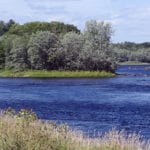From 2004 through 2009, the Natural Resources Council of Maine (NRCM) worked hard to stop Plum Creek’s sprawling development plan for the Moosehead Lake region. During a four-year permitting process that included extensive comments from NRCM, the plan was amended in many ways to reduce impacts on remote ponds and resources; significant conservation was required; and restrictions on the type, amount, and location of development were added.
When the final Moosehead Region Concept Plan was approved by the Land Use Regulation Commission in 2009 (after multiple revisions), NRCM applauded the conservation measures but had continuing concerns about the amount and location of much of the development. We appealed the decision in court, particularly due to the risks posed by a possible resort at Lily Bay. Although we won an initial court ruling, the Land Use Regulation Commission ultimately prevailed.
Now it appears that market forces may have finished the work NRCM began.
In 2019, Weyerhaeuser, one of the world’s largest timberland owners, announced that it wanted to terminate this Concept Plan that it acquired from Plum Creek when the two companies merged in November 2015. On July 15, 2020, the LUPC approved Weyerhaeuser’s termination petition and will begin a regional planning effort immediately to determine how to rezone the area covered by the original Concept Plan. Weyerhaeuser has agreed to not develop, request new development proposals, or make clear cuts until the regional planning process concludes or December 31, 2022, whichever comes first. Learn more about the Moosehead Region Planning Project, which concluded in December 2022, and its positive outcome here.
Background on Plum Creek and Moosehead Lake
In April 2005, Seattle-based Plum Creek submitted a development proposal for the Moosehead Lake region that was the largest development ever proposed in Maine. The company’s proposal called for 975 house lots, 2 resorts, a golf course, a marina, 3 RV parks—with convenience stores, beauty salons, and gas stations—and more than 100 rental cabins, right in the heart of Maine’s spectacular Moosehead Lake region.
NRCM spearheaded efforts that led Plum Creek to revise its plan two times. But the revisions didn’t address many concerns. In September of 2009 Maine’s Land Use Regulation Commission (now called the Land Use Planning Commission) approved the plan. NRCM appealed the decision and in April of 2011, a Maine State Superior Court Judge ruled in favor of NRCM’s appeal and found the Land Use Regulation Commission’s process for reviewing the Plum Creek application to have been flawed.
The "Big Moosetake" movie was created in 2005 to share information about Plum Creek's massive development plan for the Moosehead Lake region and how they could get involved to oppose this proposal. Please do not click on the link at the end of the film. That petition is no longer active. To learn more about the Natural Resources Council of Maine and our work to protect Maine's North Woods, visit www.nrcm.org/programs/forests-wildlife.
The State and Plum Creek then appealed that decision to Maine’s highest court and in March of 2012, the Maine Law Court reversed the Superior Court and reinstated the approved plan. As a result of the work of NRCM and other opponents to Plum Creek’s plan, the final plan approved by the Land Use Regulation Commission removed development from many of the most remote sites proposed for development by Plum Creek and required significantly more conservation measures in mitigation of the proposed development.
Since 2012, the major conservation measures required by the plan have been put into place:
- 29,500 acres have been transferred to the Appalachian Mountain Club for permanent protection
- 363,000 acres are now protected from future development through a conservation easement held by the Forest Society of Maine and by the State
- A trail easement allowing the establishment of 121 acres of hiking trails in the Moosehead region and a $1 million fund for construction and management of those trails has been donated to the State.
The plan approval that Plum Creek received was only a rezoning approval. Prior to any actual development, Plum Creek would have had to obtain various types of development permits.
As of early 2014, Plum Creek has not submitted any applications for any of the development activities. NRCM was the first organization to oppose this plan, which, in addition to too much development in the wrong places, proposed no additional permanent conservation. NRCM spoke out, and so did the people of Maine, including residents of the Moosehead region. In response, Plum Creek went back to the drawing board. The message was clear: the time had come for an alternative vision for the Moosehead region, one that provides permanent, large-scale conservation, concentrates development in and near existing communities, ensures development that strengthens the economy for local people, and protects the region’s beauty, character and heritage.
NRCM contracted with a land use planning firm well versed in community planning to protect scenic, ecological, and recreational resources while allowing for development that would benefit area communities. We met often with concerned citizens of the region and beyond. The result was A Vision for the Moosehead Lake Region, a 32-page, full-color publication that describes a vision that could become a model for Maine—and the nation. A Vision for the Moosehead Lake Region is an important step toward protecting the character of Maine’s spectacular North Woods.
In April 2006, Plum Creek announced a new plan, and, as part of a slick public relations campaign, claimed, "You spoke. We listened." It didn't. In fact, 93 percent of the development was still the same. NRCM continued to work hard to make the facts known. That included uncovering Plum Creek's history of forest practice violations, including the largest fine in Maine forest practice history (find the report here).
In response to pressure from NRCM, local residents, and people from across the state and beyond, on April 27, 2007 Plum Creek submitted another revised plan. The plan still called for far too much development in the wrong places, including places Maine people treasure like remote Lily Bay and the North Shore of Long Pond. LURC held four public hearings on Plum Creek’s plan in December 2007 and January 2008. Approximately 1,200 people attended one of the four public hearings; two-thirds of those who spoke opposed Plum Creek’s plan.
LURC also held four weeks of technical hearings with Plum Creek and the other 30+ intervening parties presenting testimony of about 170 witnesses. This is where the process changed dramatically. After the hearings, the Land Use Regulation Commission determined that the application wasn’t approvable as submitted. Rather than vote up or down on Plum Creek’s application the Commission decided to have its staff and consultants re-write it. Even after the staff re-wrote Plum Creek’s application for them, it included far too much development and continued to allow development in Lily Bay.
In the summer of 2008 a public comment period was opened to allow people to voice their opinion on the latest staff initiated draft. The response was overwhelming. Of the 1,768 written comments the Commission received (far more than they had received on any other issue in their history), 1,762 were opposed to the Plum Creek application. 1,517 of the comments specifically opposed development at Lily Bay. Despite this, the final Plum Creek application was approved in September 2009 and included massive development at Lily Bay.
In October 2009 NRCM filed an appeal in the Maine Superior Court. After spending countless hours reviewing LURC’s decision, and sharing the frustration of Maine people, it became clear that there were substantial grounds for an appeal and a need to do so. NRCM believed that LURC violated established laws governing how the agency was required to conduct the rezoning process. LURC invented a process for this case for which there is no legal basis. As a result, the Commission approved a final concept plan that was substantially written by its own staff and consultants, who acted as advocates for the plan. The concept plan included elements that NRCM believes would never have been approved had LURC not exceeded its legal authority.
After filing our own brief NRCM had a chance to respond to the briefs filed by the Attorney General’s Office and Plum Creek on October 18, 2010. Read our response. As a result of NRCM’s work, the Plum Creek plan was improved — less sprawling, with much improved required conservation measures, and with proposed development removed from remote ponds and other areas.
We continue to carefully track any movement on this issue. We hope you will join us in following all issues related to the protection of Maine's North Woods and forestlands by visiting our website often, becoming a member, and joining our Action Network today!
Banner photo: Moosehead Lake by Jerry and Marcy Monkman












